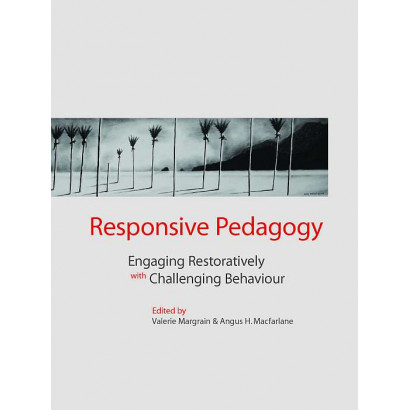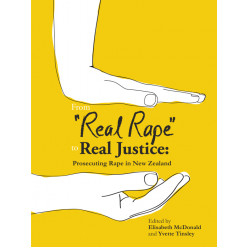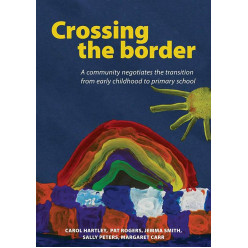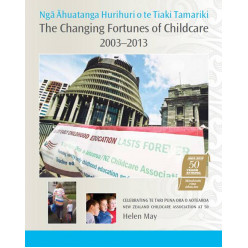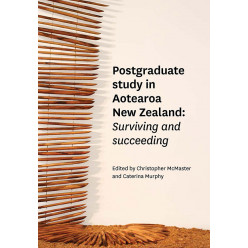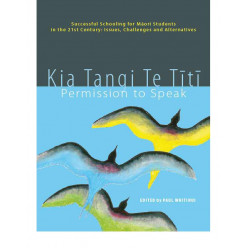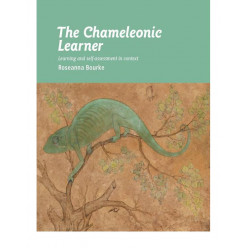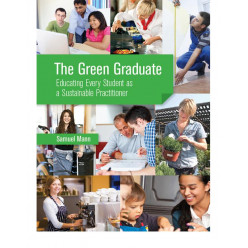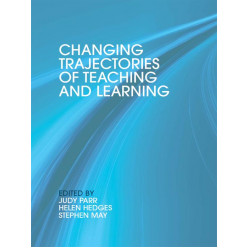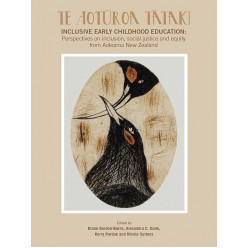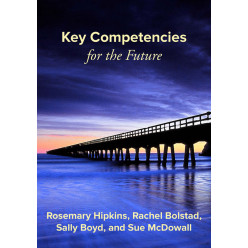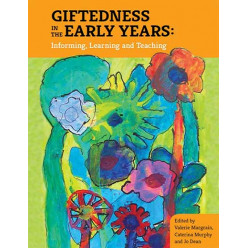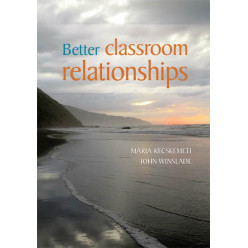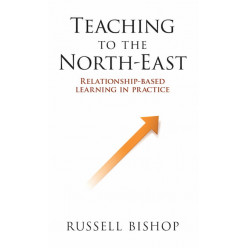Responsive Pedagogy
Immediate Download
Download this title immediately after purchase, and start reading straight away!
View Our Latest Ebooks
Explore our latest ebooks, catering to a wide range of reading tastes.
Responsive Pedagogy: Engaging restoratively with challenging behaviours.
Teachers are looking for new ways to respond to challenging behaviour. The premise of this book is that teachers can make a difference and that schools and early childhood education settings can be places where behaviour is addressed with courage and conviction.
From: Responsive Pedagogy, edited by Valerie Margrain & Angus Macfarlane
1. He tapuwae o mua: Footsteps towards responsive engagement with challenging behaviour
Angus H. Macfarlane & Valerie Margrain
Introduction
How to respond appropriately to the diverse range of challenging behaviours in society has been a topic of ongoing theorising and debate for more than a century, but it has received renewed attention in recent years (Macfarlane, 2007; Thorsborne & Vinegrad, 2006). This increased attention stems from a growing awareness that many of the current educational processes and practices are not working for a large and growing percentage of the student body—indeed, they may inadvertently be serving to perpetuate alienation and under-achievement for many students.
Traditional policies and practices may no longer manage to address many challenges arising in today’s classrooms and playgrounds.
Dilemmas abound in schools and early childhood services about how to respond to challenging behaviour, pitting individuals or ideals against one another. The community’s response is often to demand swift decisions and astute results, but swift decisions in educational settings may not be based on evidence, or may not reflect social justice, fairness or an ethos of care. Many knee-jerk approaches (such as “zero tolerance”) may actually work against achieving a potentially positive outcome for students and teachers (Lewis, 2009; Ministry of Social Development, 2007).
In this context it is worth exploring relationship-based and culturally responsive approaches such as restorative practices. Usually offered as a progressive alternative to the conventional model of exclusionary measures to control youngsters and dispense discipline, this approach is a more constructive form of conflict resolution. It may take more time, and can be supported through the use of specific protocols, but with crafted facilitation the knowledge base on restorative practices can be translated into actions that will work towards better outcomes and strengthened relationships.
Learning contexts (schools and early childhood education settings) are fundamentally relational enterprises. Authentic, caring relationships between teachers and students are fundamental to learning, as are relationships between and among students (Prochnow & Macfarlane, 2008). Add to this the reality that close, positive relationships with teachers have tangible benefits for student skill development, motivation, behaviour and learning, and the actuality becomes stark and compelling (Prochnow & Macfarlane, 2011): teaching and learning require a disposition of caring and social responsibility by teachers towards all students. This disposition must be predicated on an understanding of others. Inclusive and caring classrooms and early education settings engage learners and teachers with each other and also reach out to the community. In these settings, the values of responsibility and accountability are reinforced, and young people are supported to contribute constructively to society.
We argue that learning is socially constructed: based on social values and developed through social interactions. In a social
relationship-based approach to learning, schools and early childhood services necessarily engage with challenging behaviours in responsive ways. The use of restorative practices exemplifies having a positive belief about students, applies the constructive teaching of relationship skills and provides a positive resolution to situations that are causing conflict or harm. Relationships reign and productive partnerships between people are central: they are at the core of how people interact, build trust, support each other and behave. The more that parties work together, the greater the opportunity they have to get to know one another and to build relationships. Relationships affect everyone, and everyone can affect a relationship. However, with relationships come two key collective responsibilities: maintaining productive social interconnections and repairing any harm or damage that has affected these connections, whether caused intentionally or inadvertently.
In this chapter we set the philosophical scene for the other chapters in the book by discussing key approaches, a model for evidence-based practice and the principles of restorative justice. The remaining chapters in Part I continue to provide a rationale for responsive pedagogy when engaging with challenging behaviour, including concepts of behaviour, pedagogical care and curriculum. Part II focuses on restorative practice as a specific responsive approach that teachers use to engage with challenging behaviour. The final part of the book considers the kind of systems-level support in educational settings that enables effective teacher engagement with challenging behaviour, including leadership, staff relationships and integrated responses to the most challenging behaviours.
Footsteps from the past
It is rare that any supposedly “new” concept is truly unique. Responsive pedagogical engagement with challenging behaviour has been historically evident in many cultures and contexts (Macfarlane, Hendy, & Macfarlane, 2010). In this section we examine the historical influences on restorative practice and tie these to a range of contemporary philosophical approaches—sociocultural, ecological and inclusive, along with circumspection and cultural
responsivity—in order to illustrate the pedagogical connectedness of any response. The following whakatauki illustrates the importance of not overlooking the uniqueness and richness of past experiences and practices:
He tapuwae o mua mō muri.
Pathways from the past to guide the future.
Historical influences
Any New Zealand historical review of educational development through the decades should acknowledge the indigenous people of Aotearoa (New Zealand). Bowen (2008) points to the constructive use of responsive engagement with challenging behaviour in traditional Māori society, stating that “prior to European contact, Māori had a well-developed system of custom and process that ensured the protection of individuals, the stability of social life and the integrity of the group” (p. 7). The indigenous nature of restorative practice initiatives and the extent of commitment to this approach in New Zealand should not be underestimated. Speaking through an international e-forum, Wachtel (2007) argued that these aspects of New Zealand’s journey are significant:
While it would be an exaggeration to say that restorative justice (RJ) has completely overtaken conventional forms of justice in New Zealand, RJ has made as much headway on the island nation as it has anywhere in the world. RJ processes—mainly conferencing, based on practices adopted from the Māori people of New Zealand, in which offenders, victims and their supporters meet face to face to repair the harm caused by crimes—are being implemented in the country of 4.1 million throughout the criminal justice system. (p. 1)
An example of a community-developed indigenous restorative practice model is Te Ara Āwhina. This model has been working constructively since 1970 and continues today (Bowen, 2008). In 2007 the Ministry of Justice launched Te Whānau Āwhina, based on the model of Te Ara Āwhina. Another example of a restorative approach to effect positive change is the introduction of family group conferences to resolve complex situations.
An increase in crime rates during the latter third of the 20th century led to ongoing questioning of the effectiveness of retributive models of justice. It was becoming increasingly clear that the traditional “lock up and throw away the key” approach was not an effective or sustainable deterrent, particularly for the increasing number of disaffected male Māori youth. At the New Zealand Police Conference (Ngakia Kia Pūāwai) in 2005, Judge Becroft reported on the offending and recidivist offending rates of male Māori youth, stating that these were disproportionately high—indeed the punitive approach, he declared, appeared to be a counter-productive process (Becroft, 2005). By the 1990s, prominent Judges Brown, McElrea and Curruthers publicly articulated their concerns about the existing justice system and led the call for restorative approaches to be recognised as legitimate judicial options (Bowen, 2008; Drewery & Winslade, 2003). Formal trialling of conferencing referrals occurred within the Ministry of Justice between 2001 and 2004, followed by a thorough evaluation of conferencing concepts and procedures. The findings indicated sufficient positive outcomes for both the victims and the perpetrators of wrongdoings, resulting in restorative practice becoming recognised as a constructive judicial process.
A more recent example of wider social engagement with restorative practice is the publication of resources that link Catholic values and restorative practice. One example, A Justice that Reconciles (Caritas Aotearoa New Zealand, 2009), promotes the benefits of forgiveness. In Scotland, research has confirmed the importance of school-wide commitment to restorative practice across a range of educational settings (Kane et al., 2007). These examples illustrate that although restorative practice is new as a key concept in education, it is not entirely new in the wider society.
The first funded project to trial restorative practices in education (the University of Waikato pilot project) was undertaken in 1999/2000. The initiative was driven by the Ministry of Education’s acknowledgement that suspensions and expulsions from school were unsatisfactorily high—an acknowledgement that ultimately
initiated the Suspension Reduction Initiative (SRI). The Waikato pilot initially focused on conferencing, but later the more comprehensive te hui whakatika approach was developed (see Chapter 7). Key researchers and leaders of restorative practice in education at that time included Wendy Drewery, John Winslade, Angus Macfarlane and Ted Glynn and their associates. Mere Berryman and colleagues from the Poutama Pounamu Education Research Centre, as well as Tom Cavanagh (in New Zealand on a Fulbright Fellowship), were able to complement the work of the Waikato researchers and continue to publish and advocate for restorative practices.
Throughout the 2000s, Margaret Thorsborne has responded to calls from the teaching sector in both Australia and New Zealand for effective professional development on restorative practice interventions, such as conferencing and workplace conferencing (see Chapter 10 of this book). Most recently, Greg Jansen and Richard Matla established the educational practice-oriented website Restorative Schools, along with a restorative practice newsletter, Restore. Their contribution continues to provide New Zealand leadership and creative delivery of professional development (see Chapters 5 and 6, and http://restorativeschools.org.nz). This book both acknowledges and includes these contemporary contributors to restorative practice in education.
The Ministry of Education’s Positive Behaviour for Learning Action Plan (2010) promotes a range of programmes and initiatives for parents, teachers and schools across the country to “turn around problem behaviour in children”
(“Addressing disruptive behaviour in students”, 2011, p. 4). One of the range of programmes and initiatives is The Incredible Years, introduced to New Zealand from the United States in 2002 (Hamilton & Litterick-Biggs, 2008). Over 400 early childhood and primary school teachers participated in an Incredible Years programme during 2010. The programme “provides teachers with approaches to help turn disruptive classroom behaviour around and create a more positive learning environment for their students”, including “more consciously developing relationships with challenging students and providing incentives and praise for positive behaviour” (“Addressing disruptive behaviour in students”, 2011, p. 4). This one example within the overall government strategy indicates an expectation that teachers will ensure the learning environment is supportive, responsive, accountable and safe. But one learning environment is never the same as another. According to a New Zealand authority on restorative practice, Wendy Drewery, “Every school that I have seen implement restorative practices has done it differently, and that is appropriate … Every school has different strengths and growing edges—and different parent communities with a wide range of expectations” (“Restore and Research”, 2011, p. 2). Students arrive in class with complex histories that include the dynamics that relate to physical, social, emotional and cultural forces. While we cannot expect to understand the full complexity of these forces, we can come to understand some of the fundamental influences if we consider some of the recognised philosophical approaches that attempt to help us better understand the mix of attitudes, beliefs and actions that are ever-prevailing. It is to some of these philosophical approaches that we now turn.
Philosophical approaches
Pedagogical decisions are not made in isolation, and teaching philosophies draw on a range of models and concepts. The approaches we refer to in this section draw from the past but continue to have a strong influence on how teachers engage with challenging behaviour in contemporary settings.
Sociocultural
Current conceptualisations of sociocultural theory draw heavily on the work of Vygotsky (1978), as well as later theoreticians (see, for example, Bruner, 1996). A key feature of Vygotsky’s theory is that learning is constructed within the contexts of social interaction. Rather than looking solely at individuals, we need to consider social environments and community influences on learning. The early childhood curriculum, Te Whāriki (Ministry of Education, 1996), and the revised New Zealand Curriculum for schools (Ministry of
Education, 2007), are sociocultural documents with a vision of learners who contribute to society. Children and young people construct an understanding of what it is “right” to do in their social settings, and also learn the consequences when the rules are broken. Restorative practices of acknowledging harm and seeking to “put things right” are inherently sociocultural.
Ecological
The ecological model highlights the interaction between critical contexts, such as that between home and school, or home and the early childhood setting (Bronfenbrenner, 1979). These critical environments in a child’s world include family, teachers and peers. Relationship-based and responsive pedagogical approaches acknowledge that we need to consult with families and learn about the strengths and experiences students bring from home and other contexts. It is critical that families are helped to feel valued, respected and able to contribute to restorative decision making.
Inclusion
Inclusion is a philosophical position that advocates the right of all students to access effective educational provision and support. The central contention of inclusion is that all students are equally entitled to be educated, and that their education should be available in regular educational settings within the community. Working within an inclusive philosophy means we should expect students with behavioural challenges to be acknowledged and accounted for within regular education settings. Inclusion demands that schools and early childhood education services are safe and positive places for all, and restorative practice supports this aim. Restorative approaches support us to accept a wrongdoing and work with those who have done wrong to set things right for everyone.
Circumspection
Circumspection is about being judicious, careful, well planned and thoughtful. It acknowledges that the increasing frequency and
severity of bullying has led to specific deliberation and greater vigilance in more recent years about the importance of student safety and wellbeing (Macfarlane, 2007). Bullying behaviour needs to be effectively addressed. A fundamental aspect of restorative practice is an acknowledgment of the rights of victims to be safe and to be heard. It is important to understand that restorative practice is not a “soft” approach that avoids issues; restoration demands that those who do wrong face up to their victims and acknowledge their transgression(s), and also take responsibility for putting things right.
Culturally responsive
Culturally responsive teachers will use differentiated instruction to tailor teaching to the different needs and backgrounds of their students (Foorman, 2003; Tunmer, Chapman, & Prochnow, 2003) without resorting to cultural stereotyping or adopting a one-size-fits-all teaching approach. Culturally responsive teachers will develop a personal cultural awareness and understanding of their own biases so that they can develop the awareness and understanding of their learners in order to promote positive classroom relationships. Essentially, culturally responsive teaching is premised on building, maintaining and restoring productive and positive relationships. Restorative teachers working in culturally responsive classrooms focus on constructive experiences and resolution as opposed to resorting to punitive, reductive procedures (see reviews by Macfarlane, 2007; Meyer & Evans, 2006).
Evidence-based practice
Teachers are increasingly required to illustrate that pedagogy is informed by evidence. However, there have been conflicting interpretations of what “evidence-based practice” means. Traditional positivist or scientific notions of evidence are dominated by quantitative approaches. Such approaches can readily measure specific instances of behaviour but are less successful at understanding individuals, or at acknowledging contexts or the depth of relationships.

A model for what constitutes evidence-based practice has been developed by Bourke, Holden, and Curzon (2005) (see Figure 1.1). This model clearly challenges practitioners to consider the ranges and relevance of the evidences from which they draw. Three types or lenses of evidence are acknowledged by these authors: the research lens; the practitioner lens; and the individual/family/community lens. Bourke et al. argue that evidence-based practice is only achieved when all three lenses inform understanding, and further declare that the process of defining “what constitutes evidence” will be fraught with difficulty should individual/family/community experiences and knowledge be overlooked or marginalised. If any one of the three lenses is missing in an analysis, the evidence will have limited validity, as follows:
• Use of the research lens and the practitioner skill and experience lens without the individual/family/community lens will result in an “expert” or “medical” model. Such a model is
more likely to be deficient in its view of learner behaviour, and will fail to acknowledge family, cultural and community experiences or values.
• Use of the research lens along with perspectives from the individual/family/community, but without the practitioner lens, will be limited by the absence of practitioner skills, experience and mediation.
• Use of perspectives from the practitioner lens along with the individual/family/community, but without research evidence, will result in ad hoc, trial-and-error approaches that can result in unnecessary effort and energy.
Use of all three lenses is important to ensure effective and relevant evidence-based practice.
The model of Bourke et al. (2005) is valuable for supporting teachers in their pedagogical reflection when engaging with challenging behaviour. Teachers use the research lens when they read journals and books about ways to manage behaviour or use restorative practice. Documenting particular individual behaviours, antecedents and consequences is an example of teachers using research methods to collect relevant data. Teachers apply their own practitioner skills and experience in their everyday classroom management of individuals and groups. They also draw on the practitioner circle through professional staff/collegial discussions of challenging situations, whether in the staffroom or when working alongside specialist behaviour support staff. Practitioner skills are enhanced through professional learning and development (PL&D) opportunities.
The individual and community lens includes input from learners, parents/whānau and community members. Teachers become informed when they meet with parents at formal parent-teacher interviews, and at informal events such as family fish ‘n chip nights or hāngi (earth oven used to cook food). Wider participation in communities also enables teachers to meet students and families in settings with different values, including church, cultural and sports events. In many of these settings, student behaviour and motivation can be markedly different from that observed in classroom contexts.
Restorative principles for pedagogical responsivity
In this section we briefly consider the definition and core principles of restorative justice, and consider how these inform restorative practices in education. Part II of this book explores restorative practice in greater depth. Restorative approaches can perhaps best be defined as being in fundamental contrast to retributive approaches—they are about “putting things right” (the notion of accountability) rather than punishment.
Philosophy and principles
Restorative practice has its roots in restorative justice, a judicial approach that focuses on repairing the harm done to people and relationships rather than on punishing offenders. McCold and Wachtel (2003) describe how it originated in the 1970s as a mediation approach between victims and offenders, then broadened its scope in the 1990s to include communities of care, with victims’ and offenders’ families and friends participating in collaborative processes. At the forefront of our ideas in this book is a vision that schools and early childhood education services can use this approach to create and enhance positive learning contexts for children and young people.
Zehr (2002) describes restorative justice as “a process to involve, to the extent possible, those who have a stake in a specific offence and to collectively identify and address harms, needs and obligations, in order to heal and put things as right as possible” (p. 37). Three principles are key:
• misconduct violates people and relationships
• violations create obligations and liabilities
• restorative practice seeks to heal, put things right and restore harmony (Zehr, 2002).
This philosophy is not new, but clearly it is in opposition to the retributive philosophy. Thorsborne and Vinegrad (2004) suggest that restorative problem solving is a process that was evident in Anglo-Saxon and Roman law, and remind us that healing, compassion, forgiveness and mercy are human values that transcend many cultures

and communities. Restorative practices and philosophies have been important and fundamental elements of many relationship-oriented indigenous cultural groups, including Māori.
Table 1.1 (adapted from Thorsborne & Vinegrad, 2006) compares and contrasts restorative problem-solving philosophy with the traditional retributive and punitive approach. The table clearly shows that restorative approaches cannot be implemented at a practical level without a commitment to restorative philosophy and a rejection of retributive philosophy. Restorative justice is thus both a process and a set of values (Morrison, 2007). Chapter 5 looks in more detail at punitive versus restorative practices, along with constructive examples of restorative practice strategies and methods.
So far we have been discussing restorative justice in very general terms. Claassen (1996), at the National Conference on Peacemaking and Conflict Resolution (NCPCR), identified 10 principles of restorative justice that provide more precision to the concept:
1. Crime is primarily an offence against human relationships.
2. Restorative justice recognises that crime is wrong and should not occur.
3. Restorative justice is a process to make things as right as possible.
4. The primary victim(s) of a crime is/are the one(s) most impacted by the offence.
5. The situation is an opportunity for teaching and learning.
6. Restorative justice responds at the earliest possible time with the greatest amount of co-operation.
7. A co-operative and community structure is used.
8. Not all offenders will choose to be co-operative.
9. The impact of the crime on victims should be emphasised.
10. Follow-up and accountability are important.
These principles apply across cultures and settings to diverse learners and communities. They can be applied to communities, within schools or in early childhood education services, in families and across societies.
Restorative practice is an approach based on respect, empowerment, collaboration and healing. These aspects are constructive and affirming, ensuring positive outcomes for all involved, and are in opposition to retributive approaches. In fact, the rejection of retributive approaches is perhaps the key aspect of understanding restorative practice. Restorative practice in schools and early childhood education services might be defined as much by what it is not. Table 1.2 clarifies elements of what restorative justice is and is not. Teachers might use this table to reflect on the philosophy they wish to foster and represent in their work with learners.

Social discipline
The restorative matrix, or social discipline window, devised by Wachtel and McCold (2000), further explains the restorative approach (see Figure 1.2). Four quadrants are formed through the intersection of two axes: the vertical axis defines structure and limits, and the horizontal axis defines support and care. Approaches to challenging behaviour can be located in one of the four quadrants, as follows:
• The top-left quadrant is high on structure and limits but low on support, resulting in a punitive and authoritarian approach. This approach results in actions being done to others.
• The bottom-right quadrant is high on support and care but low on structure and limits, resulting in approaches that appear permissive, rescuing, or for others.
• The bottom-left quadrant, being low on both structure and support, is neglectful and does not resolve.
• The top-right quadrant is high on both structure and support. This approach results in respectful problem solving, collaboration and restoration with others.

Wachtel (2005) draws from this matrix by challenging us to find ways of responding to behaviour that ensure we operate within the top-right quadrant, working responsively with others. This book provides authentic case studies and practice suggestions from teachers engaging responsively with challenging behaviour.
Conclusion
There is continuing national and international frustration over how to respond more appropriately to the increasing incidence of challenging behaviours in schools and early childhood education settings. Both the education sector and wider society are increasingly considering culturally responsive and relationship-based principles and practices as a methodology to use for sound professional intervention. Principles of restorative justice, applied most noticeably in the legal setting, can be translated to the field of education as restorative practice, highlighting their universality. That said, restorative practice is no miracle intervention. The ways in which teachers, students and whānau (families) can engage constructively with students who behave in challenging ways is contingent on a range of factors. different situations require different responses, and knowing when and how to respond requires knowledge and reason.
When we are confronted with behavioural challenges we often wonder “why?” We want to know what causes that behaviour and how best to respond. Sometimes, despite our best intentions, relationships between students and teachers are tested, and matters that have gone wrong have to be put right. Engagement with challenging behaviour is most effective when informed by sound and systematic understanding, grounded in theory. The next chapter considers a number of theoretical models that provide empirically based frameworks to guide practice.
This chapter has contributed to the discussion of the historical and philosophical influences on the ways in which teachers choose to engage with challenging behaviour. It has aimed to raise consciousness by encouraging reflection about personal values, and to encourage ways of working towards constructive, relationship-based and culturally responsive practices. We argue that in order to engage effectively with challenging behaviour, seven imperatives need to be taken into account. Premised on the concept of TAPUWAE (footsteps) these seven imperatives include: effective teaching, well-considered aims, partnership, universality, wisdom, accountability and evidence-based practice, and will be revisited in many of the chapters that follow.
References
Addressing disruptive behaviour in students. (2011, February 14). Tukutuku Kōrero: New Zealand Education Gazette, 90(2), 4–5.
Ashworth, J., Van Bockern, S., Ailts, J., Donnelly, J., Erickson, K., & Woltermann, J. (2008). The restorative justice center: An alternative to school detention. Reclaiming Children and Youth Journal, 17 (3), 22–26.
Becroft, A. J. (2005, November). Māori youth offending. Paper presented at the Ngakia Kia Puawai New Zealand Police conference, Nelson.
Bourke, R., Holden, B., & Curzon, J. (2005). Using evidence to challenge practice: A discussion paper. Wellington: Ministry of Education.
Bowen, H. (2008). Restorative and healing justice in Aotearoa: A way forward for schools. Paper presented at the New Zealand Edmund Rice conference, Oamaru. Retrieved 26 April 2010, from http://www.restorativejustice.org/10fulltext/bowen-helen.-2008.-restorative-and-healing-justice-in-aotearoa-a-way-forward-for-schools/view
Bronfenbrenner, U. (1979). The ecology of human development: Experiments by nature and design. Boston: Harvard University Press. Bruner, J. (1996). The culture of education. Cambridge, MA: Harvard University Press.
Caritas Aotearoa New Zealand. (2009). A justice that reconciles. In Caritas Social Justice Series, 14. Wellington: Author.
Church, R. J. (2003). The definition, diagnosis and treatment of children and youth with severe behaviour difficulties: A review of research. Report prepared for the Ministry of Education.
Claassen, R. (1996). Restorative justice: Fundamental principles. London: Home Office, Information and Publications Group.
Drewery, W., & Winslade, J. (2003). Developing restorative practices in schools: Flavour of the month or saviour of the system? Paper presented at the AARE/NZARE conference, Auckland.
Foorman, B. (2003). Preventing and remediating reading difficulties: Bringing science to scale. Baltimore: York Press.
Hamilton, M., & Litterick-Biggs, A. (2008). The Incredible Years parent training programme in Tauranga. Kairaranga, 9(1), 44–49.
Kane, J., Lloyd, G., McCluskey, G., Riddell, S., Stead, J., & Weedon, E. (2007). Restorative practices in three Scottish councils: Final report of the evaluation of pilot projects 2004–2006. Scottish Executive. Retrieved 8 August 2009, from http://www.scotland.gov.uk/Publications/2007/08/24093135/20
Lewis, S. (2009). Improving school climate: Findings from schools implementing restorative practices. A report from the International Institute for Restorative Practices GraduateSchool. Retrieved 21 August 2009, from http://www.iirp.org
Macfarlane, A. (2007). Discipline, democracy and diversity: Working with students with behaviour difficulties. Wellington: NZCER Press.
Macfarlane, A. H., Hendy, V., & Macfarlane, S. (2010). Young people experiencing behavioural difficulties: Discourses through the decades. Kairaranga, 11(2), 5–15.
McCold, P., & Wachtel, T. (2003). In pursuit of paradigm: A theory of restorative justice. Paper presented at the XIII World Congress of Criminology, Rio de Janeiro. Retrieved 28 October 2009, from http://www.realjustice.org/library/ paradigm.html
Meyer, L. H., & Evans, I. M. (2006). Draft final report: Literature review on intervention with challenging behaviour in children and youth with developmental disabilities. Wellington: Ministry of Education.
Ministry of Education. (1996). Te Whāriki: He whāriki mātauranga mō ngā mokopuna o Aotearoa: Early childhood curriculum. Wellington: Learning Media.
Ministry of Education. (2007). The New Zealand curriculum. Wellington: Learning Media.
Ministry of Social Development. (2007). Inter-agency plan for conduct disorder/ severe antisocial behaviour 2007–2012. Wellington: Author.
Morrison, B. (2007). Restoring safe school communities: A whole school approach to bullying, violence and alienation. Sydney: The Federation Press.
Positive behaviour for learning: Addressing disruptive behaviour in students. (2011). New Zealand Education Gazette. Retrieved 22 February 2011, from http://www.edgazette.govt.nz/Articles/Article.aspx?ArticleId=8275
Prochnow, J., & Macfarlane, A. (2008). Managing classroom behaviour: Assertiveness and warmth. Paper presented at the first Educational Psychology forum, Faculty of Education, University of Auckland, Auckland.
Prochnow, J., and Macfarlane, A. (2011). Managing classroom behaviour. In C. Rubie-Davies (Ed.). Educational Psychology: Concepts, research and challenges (pp 150–166). London: Routledge.
Restore and research. (2011, May 23). Tukutuku Kōrero: New Zealand Education Gazette, 90(2), 2–3.
Thorsborne, M., & Vinegrad, D. (2004). Restorative practices in classrooms: Rethinking behaviour management. Queenscliff, VIC: Inyahead Press.
Thorsborne, M., & Vinegrad, D. (2006). Restorative practices and bullying: Rethinking behaviour management. Queenscliff, VIC: Inyahead Press.
Tunmer, W. E., Chapman, J. W., & Prochnow, J. E. (2003). Preventing negative Matthew effects in at-risk readers: A retrospective study. In B. Foorman (Ed.), Preventing and remediating reading difficulties: Bringing science to scale (pp. 121–62). Timonium, MD: York Press.
Vygotsky, L. (1978). Mind and society. Cambridge, MA: Harvard University Press.
Wachtel, J. (2007). RJ in the land of the long white cloud: New Zealand embraces restorative justice for adult offenders. Paper presented at the Restorative Practices e-forum, Bethlehem, PA. Retrieved 26 April 2010, from http://www.restorativejustice.org/articlesdb/articles/7975
Wachtel, T. (2005). The next step: Developing restorative communities. Paper presented at The Next Step: Developing Restorative Communities, IIRP seventh international conference on Conferencing, Circles and Other Restorative Practices, Manchester, UK. Retrieved 28 October 2009, from http://www.realjustice.org/library/man05_wachtel.html
Wachtel, T., & McCold, P. (2000). Restorative justice in everyday life. In J. Braithwaite & H. Strang (Eds.), Restorative justice in civil society (pp. 117–125). New York: Cambridge University Press.
Zehr, H. (2002). The little book of restorative justice. Intercourse, PA: Good Books.
